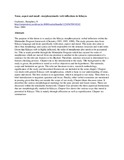| dc.description.abstract | The purpose of this thesis is to analyze the Kikuyu morphosyntactic verbal
inflection within the Minimalist Program framework (Chomsky 1993,1995,1998).
The study presents data from Kikuyu language and deals specifically with tense,
aspect and mood.
The study also aims to show that morphology and syntax are both responsible for
the sentence structure and word order. Given that Kikuyu verb is highly inflected,
the order of morphemes also needs to be accounted for. This is made possible
through the Minimalist Program which has catered for order of morphemes which
are moved from one position to another in the syntactic representation of a
sentence for the relevant features to be checked. Therefore, sentence structure
is determined by a feature-checking process.
Chapter one is the introduction to the study. The background to the study is
given, the problem is stated as well as objectives and the hypotheses. The
rationale, scope and limitation are given. The relevant literature review, research
methodology, significance of the study and theoretical framework are included in
the same chapter.
Chapter two deals with general Kikuyu verb morphosyntax, which is basic to our
understanding of tense, aspect and mood. The first section is on agreement,
which is integral to our study. Then there is a brief introduction to negation,
question and focus. Finally, other verbal extensions are mentioned in passing
given that they are outside the scope of our study.
Chapter three discusses tense. It describes the various morphological markings
for the past, present and future tenses. These are discussed within the minimalist
framework.
Chapter four presents the three aspectual distinctions that are morphologically
marked in Kikuyu.
Chapter five shows the various ways that mood is presented in Kikuyu. This is
mainly through affixation as well as suprafixation.
Chapter six summarises | en |

